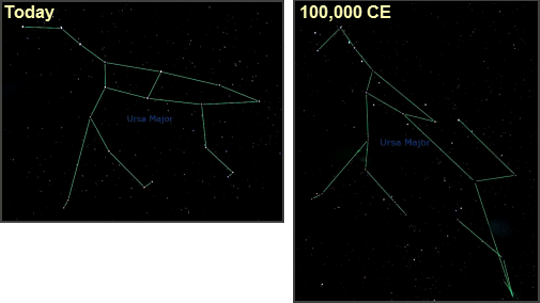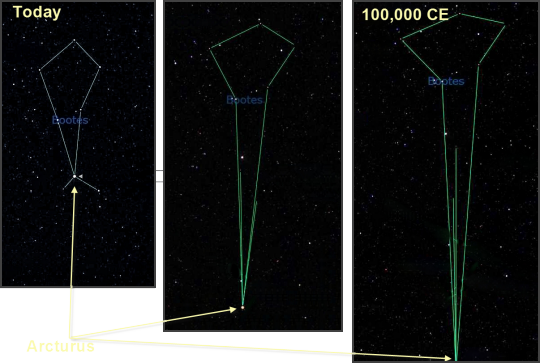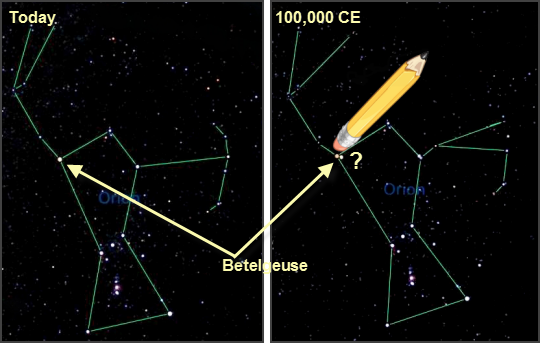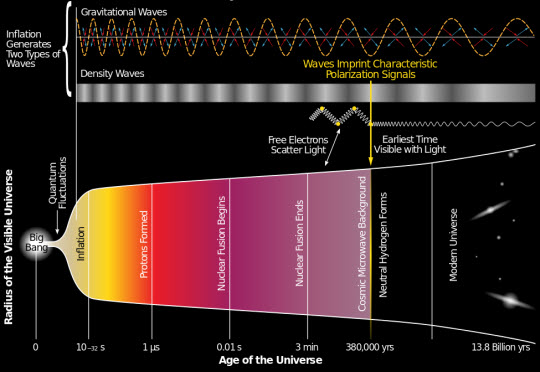Lots of Members couldn't make it to the WDAS February meeting, so here's a brief round-up of events:
How the night sky will change
Mark often shows Star Party revellers how the slow wobble of the earth's axis has changed the pole star from Thuban in the constellation Draco at the time Egyptians were building the pyramids, to Polaris in Ursa Minor as we know it today.
But in his talk in the February meeting, Mark showed that in the 98 millennia between now and the year 99,999 CE not only will there be many cycles of the earth-axis-wobble, (precession) but many of the constellations themselves will morph into completely different patterns.
For example, the familiar 'W' shape of Casiopeia changes to something resembling an inverted jug. The nearer stars Ruchbah (2nd from the left) and inparticular, Caph (right) have moved the most.

And the saucepan-shaped 'Big Dipper' asterism in The Plough will change into something more like a wok, with a dodgy handle. (chop-sticks supplied!). The star at the end of the handle (Alkaid) and the upper 'pointer' star, Dubhe are the ones to break ranks.

As well as stars changing apparent position from the perspective of our own solar system, due to their relative proximity, some stars are pretty close and heading in an different direction to the norm. One such star is the bright star Arcturus in Bootes; the brightest northern hemisphere star. Arcturus does not circle around the Gallatic Centre, but is plunging down through the galactic disk ahead of us (crossing our path). In a 100,000 yrs Arcturus will be in Virgo, indeed around 76200AD Arcturus and Spica will appear cheek to cheek in the sky, with Rigil Kentaurus steaming up from the southern hemisphere.

Still other stars may have winked out of existence entirely by the year 100,000 CE. Even now, we're waiting for Betelgeuse in Orion's left shoulder to explode in a supernova some time before then.

Inflation's signature in doubt
Andi showed a film-strip of last year's most significant astronomical discovery, and explained how new data has caused the discovery claim to be withdrawn.
Almost no time at all after the universe sputtered into existence, most cosmologists believe there was an imperceptibly brief but supremely fast period of expansion which has been called 'inflation'. It explains many of the characteristics we observe in the universe. But not everybody buys into the theory. In particular one renowned cosmologist, Roger Penrose, believes there are other ways to explain the universe we see today. So finding a 'smoking gun' of inflation would put the matter beyond doubt.
Through our telescopes we look back in history, because we observe light which has travelled since as long ago as 300,000 years after the Big Bang. But there we hit a wall, because up until that time the universe was too hot for atoms to form: electrons were not captured around an atomic nucleus, and in this state they scattered light such that the universe was opaque. We cannot 'see' as far back as the Big Bang. We can look back as far as the romantically named "last scattering surface" atoms formed and the universe became transparent. Today we observe light from this time as Cosmic Microwave Background Radiation (CMBR) which has already taught us much about the nature of the universe.
However there is a means by which we may obtain traces of the universe's earliest moments. It is thought that the rapid expansion of space by inflation would have released gravitational waves. These would have travelled unimpeded through space from the earliest times, and it is thought that their passage would have rippled space and polarised light in the CMBR. And it's this 'smoking gun' signature of gravitational waves that the BICEP team believed they had observed.

However, two factors had to be subtracted from the results received by the BICEP2 instrument at the South Pole before the gravitational energy could be concluded to be responsible, since they have an effect which is much the same as gravitational waves.
One was the gravitational lensing effect of large galaxies. And the other, much more significant factor was the effect of spinning particles of dust in the foreground of our own galaxy. The BICEP team used their best information to do this.
But since their announcement the Planck satellite, which can map the microwave sky at many more frequencies, has provided new data. It has found more dust. After re-calculating with this new data, the gravitational wave data cannot be separated from the 'noise' at statistically significant levels, and therefore the finding has been withdrawn. However, the improved data give a new platform for the BICEP team to do more research, so watch this space.
Although the news is certainly disappointing, it is greatly satisfying to see the rigour of the scientific method in action, and a great reminder of how it works. Every result is provisional: it will fall if contradicted by evidence. It is testable, and the more significant the claimed discovery, the more effort teams will expend trying to disprove it. In this case, the BICEP team believed with a certainty of 7σ (that there was only a 0.0000000001% chance that their result could have been an unlucky chance). And yet it was toppled by new data which humbled the team's best assumptions.
- Log in to post comments


